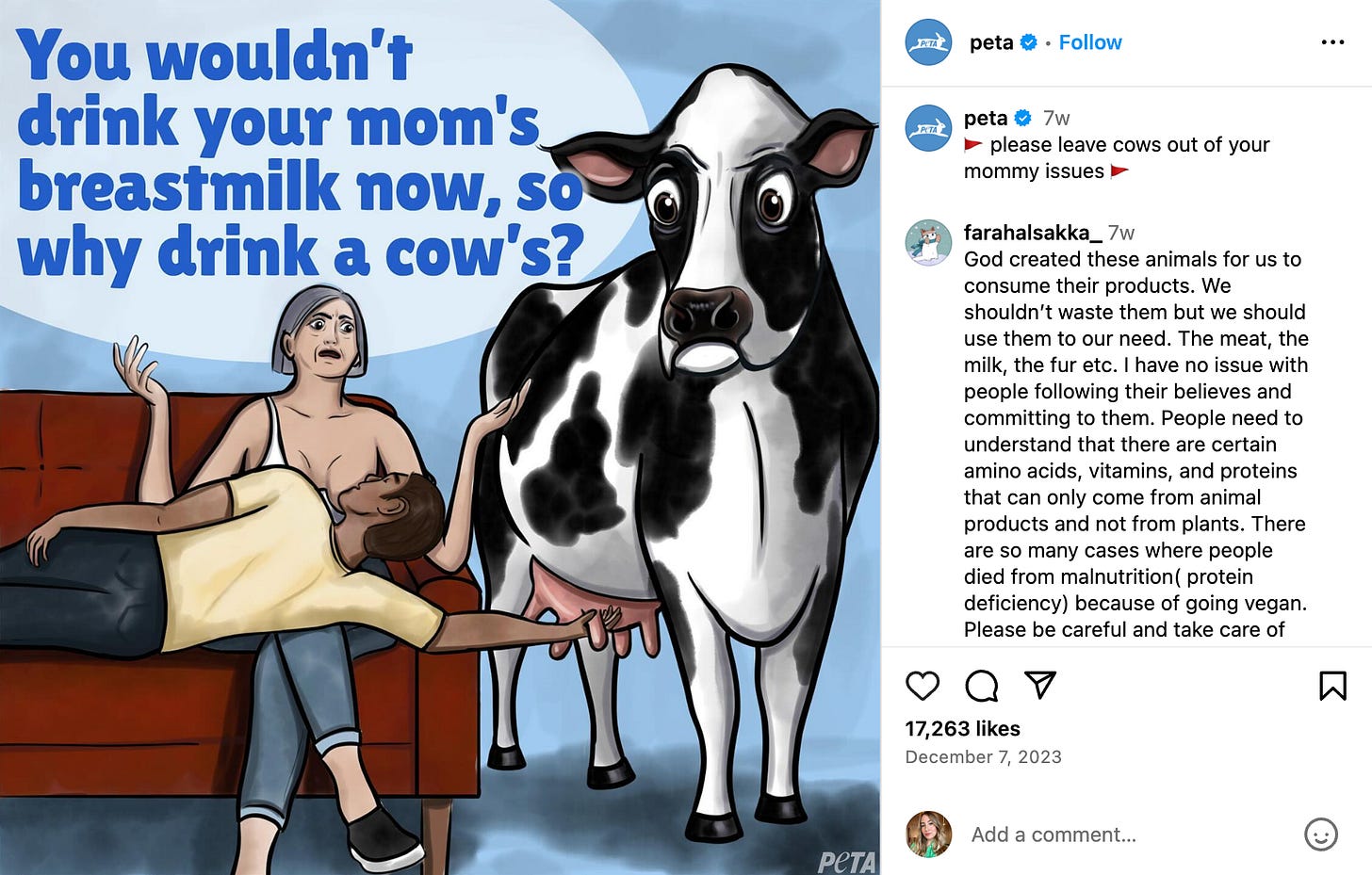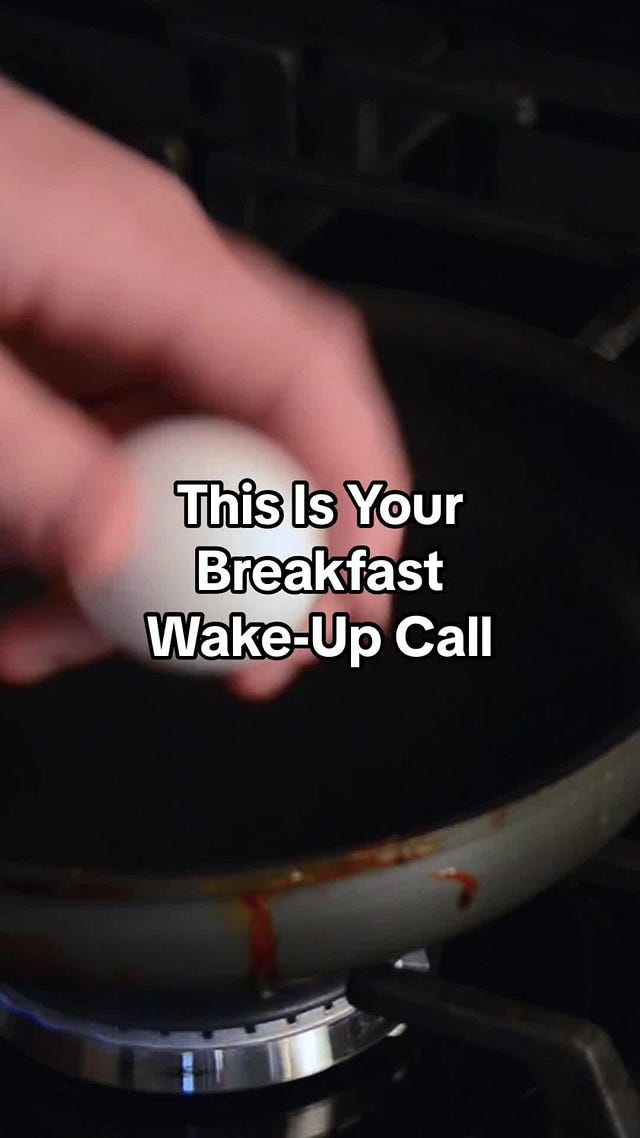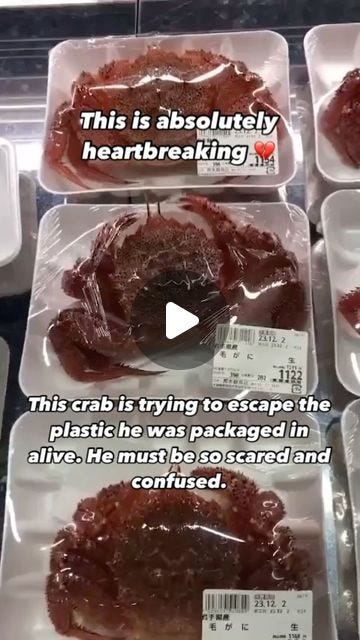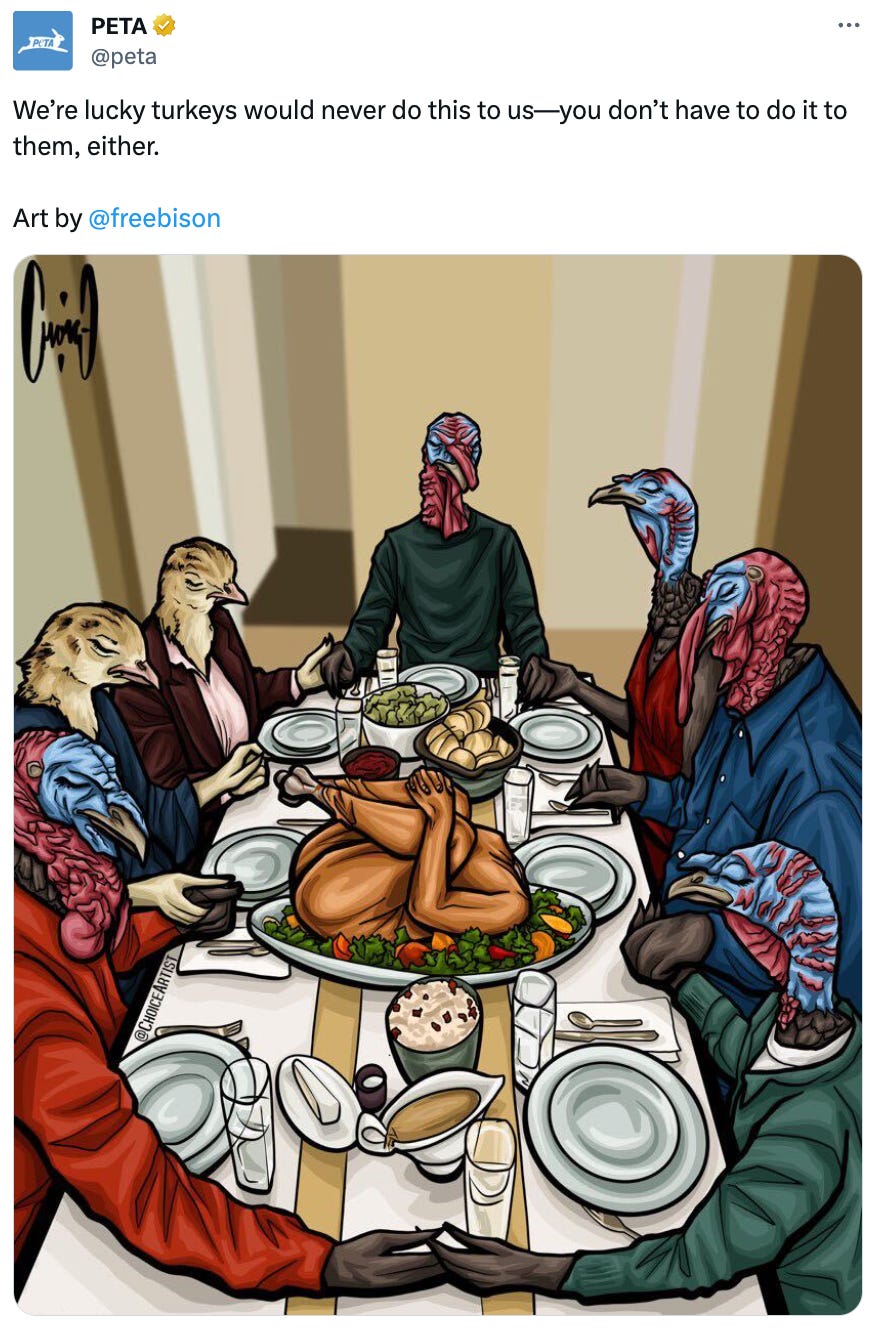How PETA Builds Shock Into Their Social Strategy
"We’re happy if people share our content in any way, including on everyone’s favorite meme accounts."
When PETA shows up in my feed, it’s usually people making fun of a post. After all, it’s not every day that you see a cartoon that says “You wouldn’t drink your mom’s breastmilk now, so why drink a cow’s?” with an illustration of a man sucking an older woman’s breast. It’s…a lot. But as I found out in today’s interview, that’s intentional.
I chatted with Ashley Frohnert, Director of Social Media at PETA, about how they build shock into their social strategy. As she puts it, “We’re happy if people share our content in any way, including on everyone’s favorite meme accounts. We want to get everyone talking and sharing, because progress needs to start somewhere!”
And if you’re wondering if it works? “Over the years, we’ve had countless people send us messages asking to unblock their accounts because they had a change of heart and decided to go vegan.”
We also chat about building awareness for causes on social, their 22 person social team, and community management when the comments are rough.
First, we've got a brief ad from our friends at Sprout Social, the social media management and analytics tool helping more than 30,000 brands deliver smarter, faster impact from social.
We talk about this a lot in Link in Bio, but you don’t need to be on every single platform. In this new article from Sprout Social, they outline why now is the time for brands to meet their audience in more intentional ways. Here are a few takeaways:
Double down on a smaller number of networks and diversify which networks you invest in
Stake your claim in the ground by leaning into unexpected platforms and owning your niche there
When you take ownership of a new (or abandoned) network for your industry, you’re most likely to build brand loyalty, increase retention and foster community

Rachel Karten: First, can you tell me about your current role and any previous social roles you’ve had in social?
Ashley Frohnert: I kicked off my social media journey as an intern for a celebrity and relationships online magazine, then later managed social content and engagement for TEDxPittsburgh and a tech startup in the Pittsburgh area.
In 2014, I took a position as a social strategist with PETA, creating content primarily for Twitter (now X). Currently, I’m the group’s director of social media and oversee 22 incredibly talented individuals. Together, we reach around 100 million people per month (or sometimes 50+ million in one day) by brainstorming and creating compelling content for Instagram, TikTok, Facebook, X, and Threads, from short-form videos and imagery to copy and illustrations. I also supervise the influencer team in ideating and building interesting, effective influencer campaigns and events.
RK: A team of 22! Wow. How would you describe PETA’s social strategy?
AF: Our number one mission is to get the world talking about animals. We do this primarily by creating content that’s relatable, easy to engage with, and timely.
Since there’s so much chatter on social media, we focus on keeping our visuals eye-catching, our captions concise and clever, and our topics as straightforward as possible.
To keep it real, we have to understand that most people don’t realize that their favorite shoes are made from cows’ skin or what really goes into making a slice of nonvegan pizza. Our job is to show them through educational videos and carousels, heartbreaking footage, illustrations, and what most people who think of our social presence might recall best—conversation-starting content. We’re also lucky to have great relationships with celebrities and influencers who share our content with their millions of followers.
 Tiktok failed to load.
Tiktok failed to load.Enable 3rd party cookies or use another browser
PETA undertakes in-depth investigations into every abusive industry, from factory farms and slaughterhouses to puppy mills and laboratories. Investigators come away with hours of undercover content, and our terrific media relations and content strategy teams tell the full story in a long format. On social media, though, we have to convey information in far fewer words, so we focus on choosing short clips that people can connect with. Sometimes, just a few seconds of an alpaca screaming while workers pull their wool out is enough to make someone decide to stop buying their wool.
Unfortunately, while nearly every platform allows brands such as UGGs to tout their sheepskin boots, Shrine circuses to post video footage of abused elephants, and McDonald’s to share videos of burgers made from cows, we’re unable to show what happens to animals due to graphic warnings and, in some cases, account freezes.
But we’re creative and turning the spotlight on animal issues in ways that’ll make viewers do a double take.
RK: When I think about PETA’s overall strategy, offline and online, there’s a shock value. Crashing fashion shows, the “hell on wheels” truck, and more. How do you use shock as a tool on social media?
AF: We’ve learned from experience that the media often doesn’t consider the terrible facts about animal suffering alone to be “interesting” enough to cover. People tend to engage on social media in a similar way.
PETA makes its actions colorful and thought-provoking, because it’s sometimes necessary to shake people up in order to initiate discussion, debate, and questioning of the status quo.
We do this by posing questions, showing people what happens to animals behind closed doors—and those images are indeed often shocking—and by initiating interactions with people, for example by asking them to present their best argument for eating bacon, sharing that chickens value their families, or even just stating that animals don’t want to be eaten.
RK: Some of the posts that come across my feed the most are these cartoons. Can you talk to me about the strategy behind them?
AF: Many people are unaware of the chain of horrific events that occur before they encounter an item made from an animal, which makes sense, as there are billion-dollar industries working hard to keep this information hidden. Our creative team uses artwork, illustrations, and AI to help folks see the direct connection, such as an UGG wearer coming face to face with a sheep who died for their boots, someone “stuffing” a turkey, or a person breastfeeding from a cow.
Our images raise eyebrows but also inspire viewers to consider how their choices have a direct impact on individual animals.
Our Thanksgiving illustrations have been massive hits year after year. This year’s collaboration with the artist Choice reached over 50 million people on X alone.
RK: I’ll be honest that sometimes they come across my feed in more of an ironic kind of way. People calling them horny or chaotic. Are they engineered to be shared in both an earnest and ironic way?
AF: We’re happy if people share our content in any way, including on everyone’s favorite meme accounts. We want to get everyone talking and sharing, because progress needs to start somewhere!
Over the years, we’ve had countless people send us messages asking to unblock their accounts because they had a change of heart and decided to go vegan.
RK: Is there a post from this year that you viewed as being really successful? What was it? What made it successful to you?
AF: For the biggest shopping day of the year, Black Friday, we prepared a video to help people avoid makeup and cosmetics that are tested on animals in labs. On Instagram alone, it earned nearly 39 million plays and over 907,000 shares.
Getting in on the Black Friday conversations about what to buy and what not to buy with educational content that users want to share with their friends and save for the future achieves our goal of helping people understand how easy it is to help animals with our shopping habits.
RK: When I look through the comments on PETA posts they are kind of brutal. What’s your strategy for monitoring? Does it ever take a toll on your mental health?
AF: Comment sections can be wild, but we’re so lucky to have hundreds of people asking how they can help animals, shop animal test–free, or go vegan. We have a wonderful team of correspondents who monitor our comments and respond with the help of Sprout Social and other tools.
Although we roll our eyes when scrolling through posts from trolls, the comments showing people’s emotional reactions to the content help keep us going. Nothing is better than sharing a victory—like rescuing beagles from a facility that breeds them for experiments or finally seeing Canada Goose phase out coyote fur—and seeing our audience reply with “I’ve been waiting for this. I took action months ago!”
RK: For other social managers who run accounts for specific causes, what are three pieces of advice you’d give?
AF:
The internet is often completely ignorant of your message and cause, so you have to talk to folks in basic, relatable, understandable, and digestible terms.
Emotion, emotion, emotion! Use it.
Every post needs to have a goal. Are you sparking action, raising awareness, asking for engagement, or just seeking shareability?
Quick reminder that there are some really great new postings on the Link in Bio Job Board. There are open positions at places like Patreon, Duolingo, Beekman Social, The New York Times, Crocs, L.A. Clippers, and more. Check them out here. If you are a brand looking to hire within social marketing, this job board is for you too! You can post your job listings here.
Okay! See you all next week!













While I am skeptical of social media as a whole, I do admire PETA for understanding how people behave inside these platforms and the kinds of things algorithms want to amplify.
I'm not the target user for these ads but that is better than other brands who go out of their way to avoid offending anyone. These brands aren't able to reach their goals and stay stuck in a neutral zone.